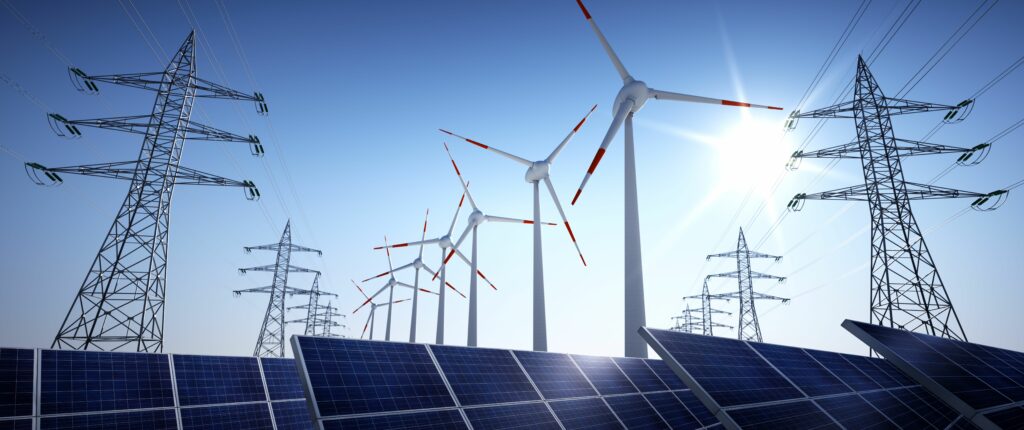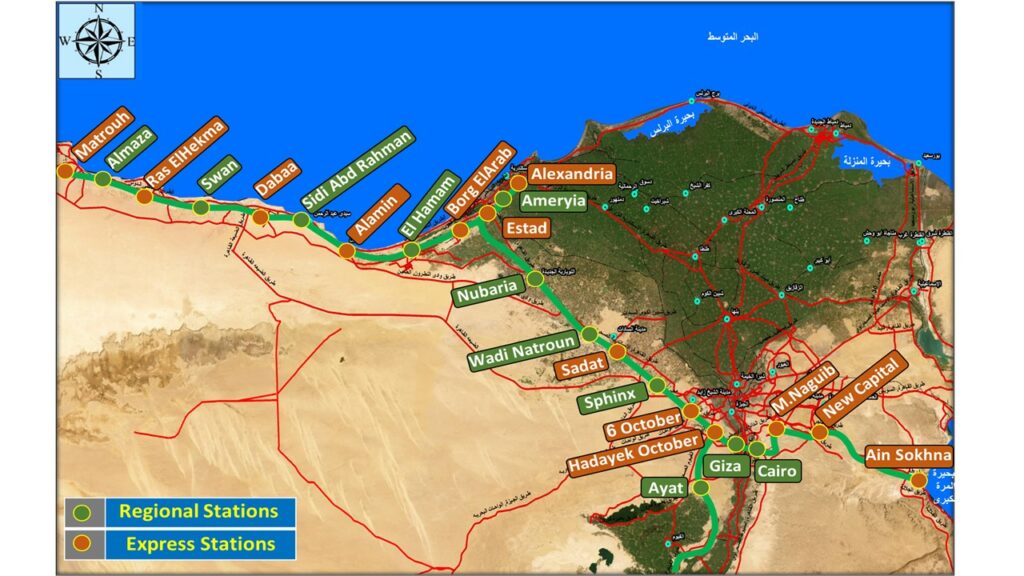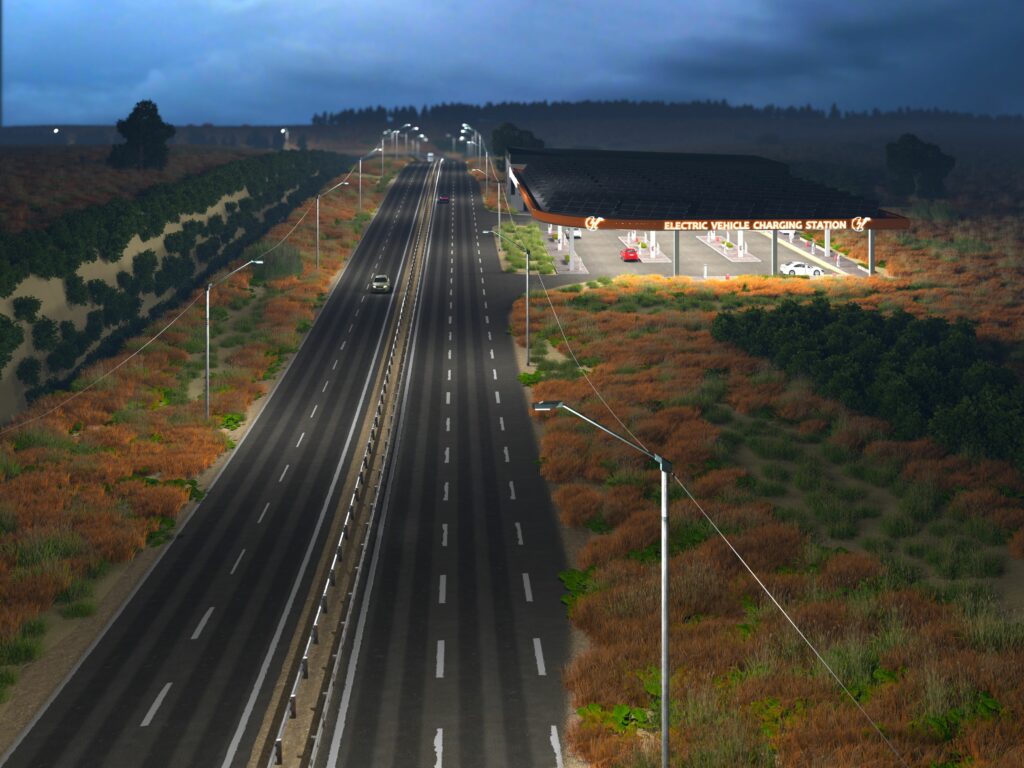In the fight against global warming, many countries are relying on the electrification of mobility to help achieve the goal of net zero carbon emissions by 2050. At the same time, national plans include decarbonising energy production by introducing more renewable energies and, in some cases, nuclear power.
These transitions require significant developments for national, regional and local electrical infrastructure: the high-voltage transmission network that moves electricity around a country, the multiple lower voltage distribution networks which take electricity to where it will be used, infrastructure for electric rail and charging points for electric vehicles (EVs).
In the fourth article in our energy transition series, we look at how the electrification of mobility, decarbonisation of electricity production, and development of electricity networks and charging infrastructure are all interlinked. Our previous articles looked at the broader links between energy transition and decarbonisation, the vital role that public authorities play in energy transition and how digital tools and data can drive transition.
Developments of electricity networks must meet the demands of new uses and increasing amounts of electrified transport and must cope with periods of peak demand. The challenges of intermittent power generation from sources such as solar and wind power and fluctuating demands for power will require mesh networks, which link multiple energy sources and destinations, to provide flexibility and resilience.
As our case studies from France, Egypt and the UK demonstrate, the transition to electricity for multiple mobility modes will impact more on distribution networks than on transmission networks. The incorporation of renewable energy will require significant investment and developments in transmission networks.
In France, the challenges of meshing and peak power for the electricity transmission network of a developed country in transition
Ambitious national carbon reduction targets go hand in hand with plans to significantly increase the production of renewable electricity. The higher the proportion of renewable energy in the electricity production mix, the bigger the challenges due to the gap between intermittent production and peak power demand. The capacity of transmission networks must be upgraded, and mesh networks deployed to connect multiple renewable energy sources and provide flexibility for peak and off-peak power periods.
France’s national low carbon strategy calls for a 40% decrease in energy consumption by 2050, driven by advances in technology, public policies such as the retrofit of buildings, and the electrification of vehicles: this is a complex challenge since energy consumption in France only decreased by 7% over the last 20 years (2000-2019, period without Covid effect), the yearly effort will need to be multiplied by around 41.
French electricity transmission network operator RTE, in its ‘Futurs énergétiques 20502’ baseline scenario forecasts that demand for electricity will increase from 480 TWh in 2019 to 650 TWh in 2050, half of which will be driven by the electrification of transport.
To face these conditions, RTE identified on the production mix scenarios, that France’s solar power production will need to increase by a factor of between 7 and 21 (2019 reference year), onshore wind between 2.5 and 4, and offshore wind capacity grow from less than 1 GW to between 22 and 62 GW. RTE concluded that this could lead to an extension of the existing 105,000km transmission network in 2020 of between 8,000 and 33,000km by 2050. In the shorter term, between 2030 and 2035, RTE will need to triple its annual investment in the transmission network, compared to the previous decade3.
1IEA
2RTE
Case Study: Transparent communication prevents delays in delivery
SYSTRA assists RTE with these challenges through 2 critical activities to deliver the strategy on the ground: public consultation and works supervision. Indeed, although most people understand the need to switch to renewable energy, they may be less supportive of the idea if it means that underground or aerial infrastructure like electricity transmission pylons are to be installed close to their homes and businesses or may run through their land. Time spent communicating and consulting with local communities, authorities and other organisations will mean less time will be lost to delays during delivery of the project due to opposition from those affected by the works.

In a project to install a new 400 kV, 80km-long transmission network between the Normandie and the Hauts-de-France regions, SYSTRA supported the network operator through the public consultation process, consulting with all the relevant stakeholders who would be impacted by the new high-voltage line years before the first works in the field. Following a comprehensive study to establish who would be affected, the operator met with 150 stakeholders over a two-month period, providing and gathering information and opinions through public presentations, information dissemination and debates. As with any major infrastructure project, some opposition remained, but by creating a culture of transparency and trust, everybody understood what was happening and why and the project proceeded without disruption.
In Egypt, enhancing electrified rail mobility with a robust distribution network in a fast-developing country
For countries with fast-growing populations, there are multiple challenges linked to energy demand, mobility and transitions away from fossil fuels. Energy and mobility infrastructure must ramp up to boost standards of living and the growth of local and national economies.
Egypt’s population is increasing at a rate of between 1.5% and 2% each year, reaching 114.5 million4 in 2024, up from 86.8m in 20145. In the 10 years 2012-2021, its electricity consumption grew by almost 13%6. Clearly, as the population grows so does its demand for electricity.
Egypt’s current inter-city rail transport system is based on low speed, majority single-track and diesel-powered vehicles. A modern electrified rail network is needed to connect its existing cities and new urban developments as well as industrial areas, providing sustainable mobility for people and for goods.
At the same time, Egypt has set itself targets as part of its Egypt vision 2030 national programme to reduce its greenhouse gas emissions by 10% by 2030, compared to 2016, with a 10% reduction target for its energy sector. It plans to grow its proportion of renewable energy production from 9% in 2016 to 40% in 2030, mainly through solar and wind power, and increase its nuclear power from 0% to 9%. The country is also aiming to improve the energy efficiency of its electricity transmission and distribution network, reducing total losses from 15% to 8% between the place of production and the place of consumption.
6IEA
Case Study: Resilient rail electrification to serve Egypt’s rapid growth
One of Egypt’s major infrastructure programmes sees the creation of a new high-speed rail network, the green, blue, and red lines which will be fed by overhead catenaries. By 2035, there will be 2,000km of new lines connecting the country’s established and developing areas, reducing the rate of road traffic growth and its associated impacts such as congestion, emissions, and pollution.
High-speed Green Line which is under construction

SYSTRA is the client’s representative on the construction of the high speed network, of which the first phase is comprised of the 660km green line which will run from Ain Sokhna on the Red Sea to Alexandria and Marsa Matrouh on the Mediterranean. SYSTRA is in charge of project management, design review and site supervision.
The initial passenger demand is more than 170,000 per day and direction on the main section, is to be doubled after 20 years. The initial freight capacity is up to 4 million tons of goods per year, saving up to 5 million tons of carbon emissions per year. In addition to the 250kmph high-speed trains, the line will accommodate 160kmph regional trains and freight trains which will operate between multi-modal logistics hubs.
Powering the line requires electricity to be delivered by the 220 kV high-voltage grid to feed ten 25kV traction substations. Since some of the traction stations are up to 60km away from the current grid, the project requires the construction of new distribution lines.
Should one substation go out of service, the line could be fed from adjacent substations, providing resilience for the service. By using the state-of-the-art 2x25kV catenary power feed technology, the system will supply a power equivalent to that of one 50kV catenary, thus optimising energy efficiency, since there will be less loss due to the Joule7 heating effect, with less electrical current running along the catenary.
In the UK, meeting growing EV charging needs in a developed country
For many developed countries, one of the core drivers of their mobility decarbonisation strategy is to increase the uptake of EVs among car users. To do that, drivers need the assurance of a charging network that will allow them to get from A to B, without too much queueing or additional journey time to find charging points.
In the UK, most charging is likely to take place at or near home or at work, but longer journeys will still require an en-route charge. The risk is that if drivers perceive that the charging network is not adequate, the negative impacts on decarbonisation could be significant. Some people will leave it later to switch their cars from petrol or diesel to EVs, leading to a slower rate of carbon emission reduction.
Peak travel days – when people are heading out on longer journeys for holidays or to visit family – put different demands on the EV charging network, compared to average travel days. This variability of demand for en route charging must also be considered when planning EV supply equipment (EVSE).
Case Study: Optimising public en route EV charging to maximise carbon savings
The UK’s Climate Change Committee (CCC) commissioned SYSTRA8 to investigate the differences between average and peak demands (both traffic and EV charging) on the UK’s strategic road network – motorways and main roads managed by National Highways. The Committee is an independent body set up under the Climate Change Act 2008 to advise the UK Government on meeting emissions targets, and to report on progress.

SYSTRA’s study for the CCC looked at the impacts of different scenarios for growing the charging network, using our in-house En-Route Charging Optimisation (ERCO9) tool. The study considered issues including the increasing range of EVs over time and changes in behaviour, as EV owners’ ‘range anxiety’ decreases.
By selecting and modelling 29 strategic routes across England and Scotland, the study showed that peak demand for EVSE did not necessarily occur at the same time as peak traffic flows, with the top 5% of peak demand for en route charging occurring on key weekends.
The modelling revealed that in 2022 there was already a gap between EVSE demand and existing infrastructure in the preferred decarbonisation scenario: with peak demand requiring over 40% more charging points to meet the level of service that the current infrastructure provides on a typical weekday. By 2050, the demand would require 3 times the existing EVSE, even after the significant predicted increase in the range of the various EV fleets.
By optimising the network to meet peak demand, a yearly carbon saving of 1.1 kilotons in 2035 and 2 kilotons per annum by 2050 could be achieved, compared to a scenario where no new EVSE were installed.
Relying on commercial decisions to expand charging infrastructure would not necessarily result in sufficient EVSE to achieve these carbon savings, with the results suggesting that Government support or regulation may be needed to ensure there are enough charging points to meet the peak demand. Given the significant infrastructure construction this could result in; an alternative to permanent infrastructure could be portable charging facilities, provided for the relevant ‘peak-demand’ locations, as and when they are needed.
Conclusions
The development of electrical infrastructure – transmission and distribution lines, electrified rail and charging points for EVs – is vital for the decarbonisation of mobility. In formulating plans for the development of transmission and distribution networks, authorities and operators must factor in the need to connect more energy sources while coping with intermittent renewable energy production, growing demands for electricity, and fluctuations such as those due to peak power periods.
Electricity networks are already vital, supporting a whole system of other infrastructures: buildings, industry, water supply and mobility. As both developed and developing countries transition contributing to net zero economies, they will become even more crucial to our economies and to our lives.
 Australia
Australia  Brazil
Brazil  Canada
Canada  China
China  Denmark
Denmark  France
France  India
India  Indonesia
Indonesia  Ireland
Ireland  Italy
Italy  Malaysia
Malaysia  New Zealand
New Zealand  Norway
Norway  Poland
Poland  Saudi Arabia
Saudi Arabia  Singapore
Singapore  South Korea
South Korea  Sweden
Sweden  Taiwan
Taiwan  Thailand
Thailand  United Kingdom
United Kingdom  United States
United States  Vietnam
Vietnam 





